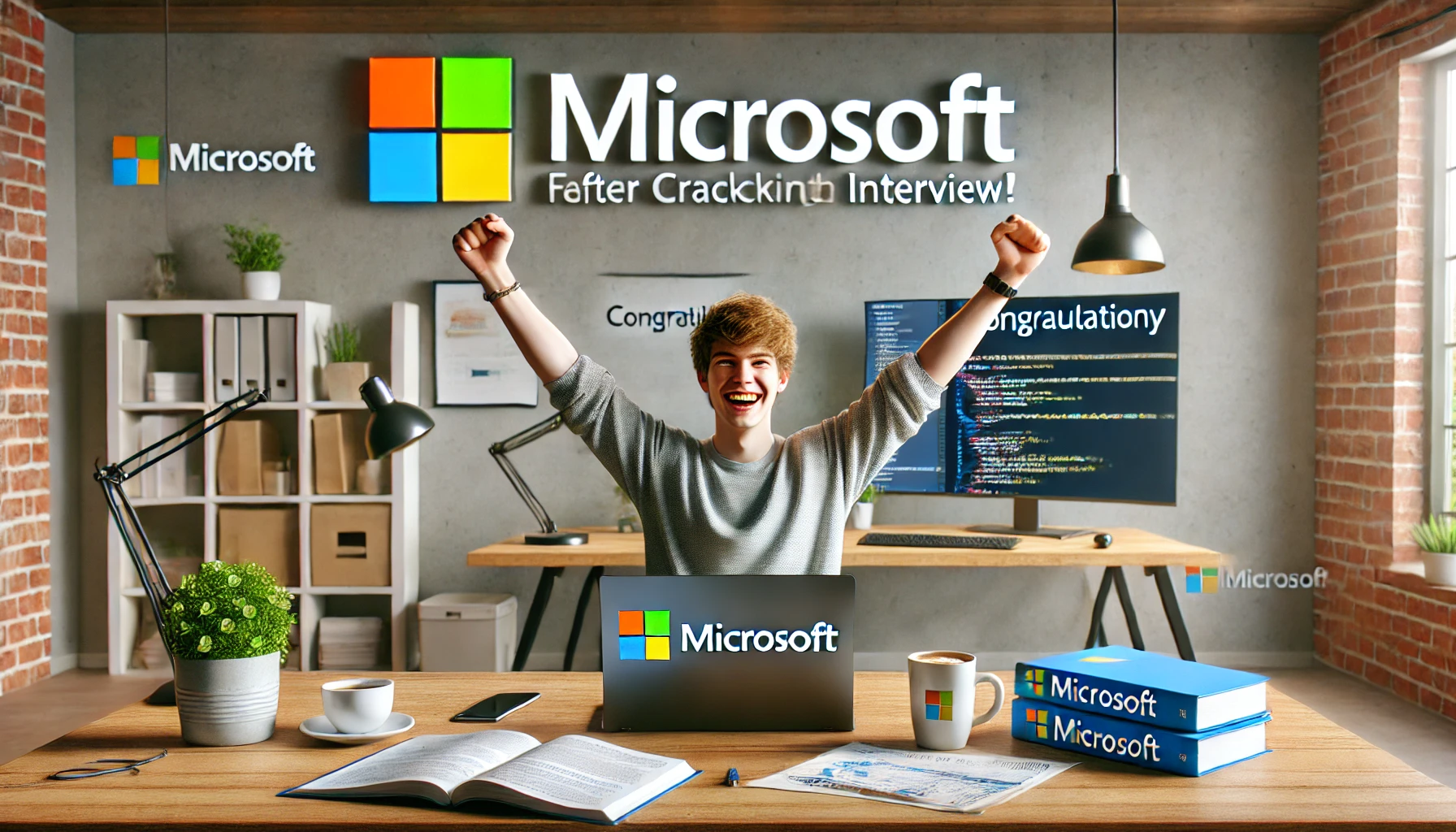How to Crack the Microsoft Interview: A Step-by-Step Guide
 Binshad
Binshad
Microsoft is one of the most prestigious tech companies in the world, offering software engineering roles to talented individuals who can solve complex problems, write efficient code, and demonstrate strong leadership and communication skills. Cracking the Microsoft interview is no small feat, but with the right strategy, preparation, and mindset, you can increase your chances of securing your dream job.
In this guide, I will share a detailed preparation plan, insights from real interview experiences, a daily routine for structured study, and tips to get through Microsoft’s interview process, specifically for freshers.
Understanding the Microsoft Interview Process
Before starting preparation, it is crucial to understand how Microsoft selects candidates. The hiring process usually consists of the following stages:
Online Assessment (OA): A screening round with 2-3 coding problems on platforms like Codility or HackerRank.
Technical Phone Interview: A 45-60 minute session with a Microsoft engineer, testing problem-solving and coding skills.
Onsite/Virtual Interviews: Multiple rounds, including:
Coding Rounds (2-3 rounds covering data structures and algorithms)
System Design (for experienced candidates)
Behavioral Interviews (assessing teamwork, leadership, and problem-solving)
Hiring Committee Review: Final evaluation based on performance in previous rounds.
A Fresher’s Journey to Cracking the Microsoft Interview
Let me share the inspiring story of my friend who cracked the Microsoft interview as a fresher. He was in his final year of college when he decided to apply for Microsoft’s New Graduate Software Engineer role.
The Beginning: Where It All Started
With no prior experience in cracking big tech interviews, he started from scratch, setting a goal of six months to prepare thoroughly. His plan included daily problem-solving, system design basics, and improving communication skills for behavioral interviews.
The Daily Routine for Microsoft Interview Preparation
A structured routine played a crucial role in his preparation. Here’s how he divided his day:
Weekdays Routine (4-6 Hours per Day)
8:00 AM - 9:30 AM: Solve two coding problems (one medium, one hard) on LeetCode.
10:00 AM - 12:00 PM: Study a data structure topic (e.g., trees, graphs, DP) and implement related problems.
1:00 PM - 2:30 PM: System design (for experienced candidates) or object-oriented design basics.
4:00 PM - 5:00 PM: Mock interview practice on Pramp or Interviewing.io.
6:00 PM - 7:00 PM: Revising previous mistakes and optimizing solutions.
Weekend Routine (6-8 Hours Per Day)
Mock interviews with friends or mentors.
Coding contests on Codeforces or LeetCode.
Behavioral interview preparation using the STAR method (Situation, Task, Action, Result).
Resume and application strategy: Tailoring the resume for Microsoft and networking with employees on LinkedIn.
Step-by-Step Preparation Plan for Microsoft Interview
Step 1: Mastering Data Structures & Algorithms (2-3 Months)
Microsoft expects strong problem-solving skills, so DSA is the most critical part of preparation. The key topics include:
Arrays and Strings (sliding window, two pointers, hashing)
Linked Lists (reversal, cycle detection, merging)
Stacks and Queues (monotonic stack, LRU cache)
Trees and Graphs (BFS, DFS, shortest paths, dynamic programming on trees)
Dynamic Programming (memoization, tabulation, optimal substructure)
Sorting and Searching (binary search, quicksort, mergesort)
Resources:
LeetCode: "Top Microsoft Questions"
GeeksforGeeks: Interview preparation guide
Cracking the Coding Interview by Gayle Laakmann McDowell
Step 2: Practicing System Design (For Experienced Candidates)
If applying for SDE-II or above, system design is crucial.
Learn fundamentals: Load balancing, caching, SQL vs NoSQL, microservices.
Practice designing real-world applications: URL shortener, rate limiter, chat application.
Resources: "System Design Primer" on GitHub, "Designing Data-Intensive Applications" by Martin Kleppmann.
Step 3: Behavioral Interviews & Soft Skills (1 Month)
Microsoft emphasizes cultural fit and leadership skills. The STAR method is an excellent way to structure answers.
Common Questions:
Tell me about a time you worked in a team and faced a challenge.
How do you handle disagreements in a project?
What motivates you to work at Microsoft?
Resources:
"The Google Resume" by Gayle McDowell
Microsoft’s career page for leadership principles
Step 4: Applying and Networking for Microsoft
Apply early through the Microsoft careers page.
Reach out to employees on LinkedIn and ask for referrals.
Participate in Microsoft hackathons and hiring challenges.
Tailor your resume to highlight projects and problem-solving experience.
How Long Does It Take to Prepare for Microsoft?
For a fresher, 4-6 months of dedicated preparation is usually enough.
First 2-3 months: Focus on DSA and coding problems.
Next 1 month: Work on system design and behavioral questions.
Final 1-2 months: Mock interviews and refining problem-solving speed.
Microsoft Fresher Program
Microsoft offers fresher opportunities through:
Microsoft New Graduate Program: Direct hiring for freshers from campus.
Microsoft LEAP Apprenticeship Program: A structured training and hiring program.
Microsoft Explore Internship: A pre-final year internship that often converts to a full-time job.
Final Thoughts
Cracking the Microsoft interview requires discipline, consistent practice, and a problem-solving mindset. By following a structured plan, improving coding and system design skills, and preparing for behavioral rounds, you can significantly increase your chances of success.
Call to Action
If you're preparing for a Microsoft interview, share your experience in the comments below! Let’s help each other succeed. 🚀
Subscribe to my newsletter
Read articles from Binshad directly inside your inbox. Subscribe to the newsletter, and don't miss out.
Written by

Binshad
Binshad
💻 Exploring the intersection of technology and finance. 📈 Sharing insights on tech stocks, market trends, and innovation. 💡 Simplifying the complex world of investing